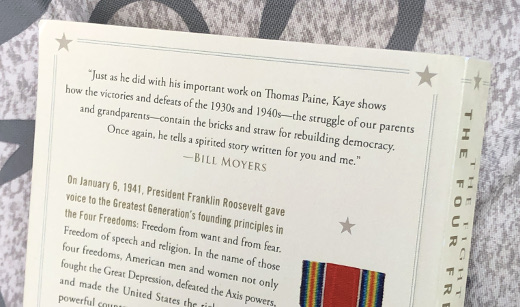My Takeaways From The Fight For The Four Freedoms
For myself growing up in New England, I was always interested and intrigued about the history of the United States. As a child, I was engrossed with the celebration of the Bicentennial of our country. Being in the area where early events in America happened, it was almost like I was absorbing history rather than studying it.
For a lot of the rest of the history of my homeland, however, I don't know it to the same level of depth. Much of it to me is top-line to the timeline, but without a lot of the minutiae. This is why I was interested in reading The Fight for the Four Freedoms by Dr. Harvey Kaye. I learned about the book after I heard Kaye on local radio interviews. I borrowed a copy of the book from a friend to learn the author's take on this time in history.
My takeaways from the book were a mix of thoughts on myself and history.
I had no recollection of ever learning about the Four Freedoms – As I read through the book, I often ask myself, why didn't I already know about this? Thinking back on what I learned in public schools, that one history class in college, stories from family members who lived through that era as well as my own personal reading, I knew a lot of the basics – the Great Depression, President Franklin Delano Roosevelt (aka FDR), the New Deal, Social Security and of course the U.S.’s entry and time in World War II. All things considered, I can’t recall the Four Freedoms at all.
In short, the Four Freedoms were goals or quests FDR had for America: freedom of speech, freedom of worship, freedom from want and freedom from fear. He first presented these when he addressed Congress in January, 1941. I know the first 2 are in the U.S. Constitution. The last two, in my own assessment, are “covered” with the phrase “life, liberty and the pursuit of happiness” in the U.S. Declaration of Independence.
There were a lot of government “acronym” agencies during this time, and now – Thinking back on my own history lessons, I knew about the Work Progress Administration (WPA) and the Tennessee Valley Authority (TVA), but that was about it. The book lists programs after program, agency, after agency, and all were referred to the acronym for their much longer names. We of course have this today, with new ones created just this year. If I were to look back my guess is there were more in between and even before this time. Each acronym comes with its own overhead needs to exist: budget, staff, etc., and one always hopes the results are worth the effort to create it.
History plus opinion of this period of time – I knew going into the book, from listening to him on radio interviews, the author has strong liberal / progressive political views. As I read the book, this was evident in the very positive tone given to FDR and all that government did, in contrast to the negative tone towards business and free enterprise. Granted from my own knowledge I know all wasn’t good from business, and many had the same feelings towards the government. I was able to read beyond this, however, and still got the essence of the Four Freedoms. Not bad for a self-described centrist and supporter of business and entrepreneurship.
I recommend The Fight for the Four Freedoms for anyone who is interested depth on this topic and period of time. It painted a good picture of the beliefs of FDR, those who followed him and the meaning behind his goals. As I borrowed this book, I returned it to its rightful owner and did not pass this one onto someone else.
This is from The Hot Iron, a journal on business and technology by Mike Maddaloni.
Did you enjoy this? Subscribe to The Hot Iron by RSS/XML feed or Read by Email
Book Take-Aways • (0) Comments • PermalinkComments
Post a Comment
Note: Comment moderation is active, and your comment will be viewable once it is reviewed.


